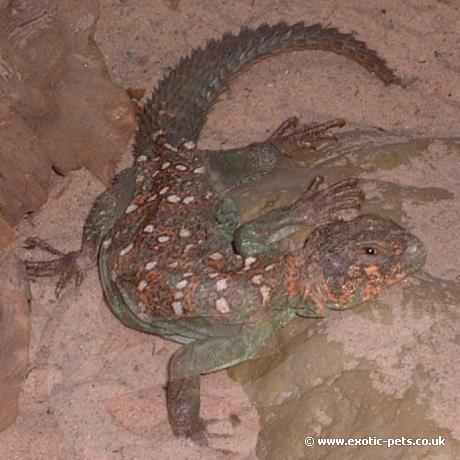

The Ocellated Uromastyx or Ocellated Dab-tailed Lizard as it is also known is a spiny tailed lizard that lives in arid desert regions, within rocky areas.
The Ocellated Uromastyx is one of the smaller sized species, these are still large growing to 25-30cm (10-12 in). They are among the most colourful species of Uromastyx to own, they are a bluish/grey colour with orange and white patterning along their back. They are easy to handle unlike some other species.
They come from hot arid area in southern Egypt and Sudan.
You should house one specimen per enclosure (unless breeding), this being a minimum of 3ft when adult.
Ideally provide an adult Uromastyx with 6 inches of sand to allow burrowing. A number of shelters must be placed throughout the enclosure, these are mainly made out of rock slabs or reptile caves. Lightly mist under one hide every few days to maintain a 50-65% humidity level, this should not be any higher then 70%.
Uromastyx require very high temperatures, the basking area should reach 49-60C (120-140F), the remaining vivarium temperature should be roughly 26.5-32C (80-90F). A night time drop to 18C (65F) should be allowed. It s very important to have all lamps connected to a thermostat, you should never guess the temperature. Provide a 10% UV-B strip light or a UV-B mercury vapour lamp. The latter may cost but the UV-B travels much further than the strip lights, this bulb also gives off heat for basking.
Feed baby Uromastyx every day, adults every other day. They feed on a range of leafy greens and seeds;
Try to avoid the cabbage vegetable such as broccoli, brussels sprouts and also spinach, these foods may interfere with calcium intake. Babies and juveniles will take the odd insect, offer a few each week. Add a calcium supplement with a small amount of Vitamin D to their food, babies are fast growing and require this more than adults. You can also use the T-Rex Sandfire Uromastyx dust.
Adult Uromastyx do not require a water dish, they seldom or never drink from open water. Babies do need more water, once a week place them in a shallow water dish to hydrate by drinking and soaking.